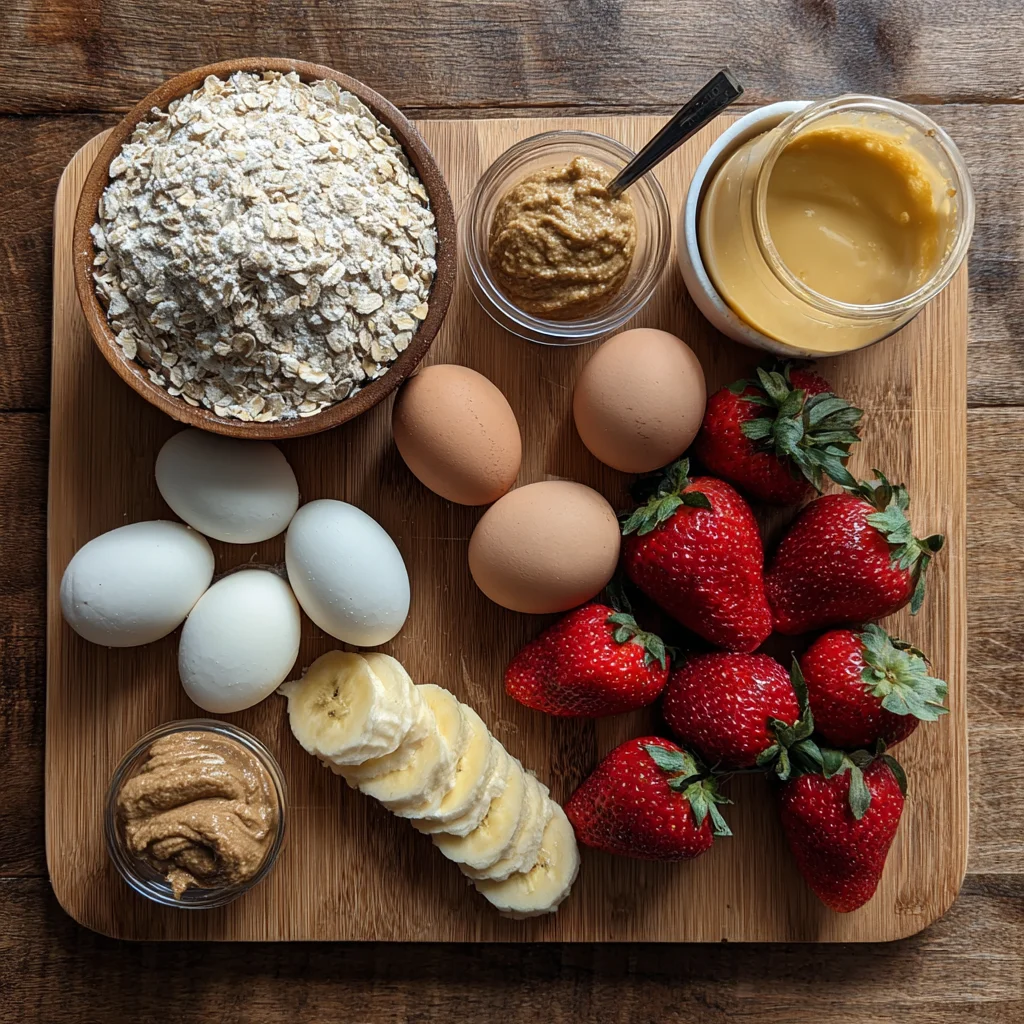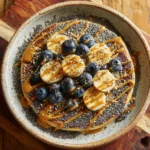Looking for a protein-packed breakfast that’s both delicious and diet-friendly? Meet the protein pancake bowl—a creative twist on the traditional pancake stack that’s built to energize your morning and keep you full longer. Instead of flipping pancakes one by one, this bowl combines all the good stuff—protein powder, oats, nut butters, and fresh fruit—into one quick, easy-to-eat meal.
Whether you’re training hard or just trying to stay ahead of mid-morning hunger, this bowl delivers balanced macros without the crash. Throughout this guide, we’ll explore everything about protein pancake bowls: from what they are, why they’re popular in fitness communities, how to make them, and why they might just be your new favorite breakfast.
Check out our Protein Coffee Recipe to Boost Your Morning Routine.
Table of Contents
Table of Contents
What Is a Protein Pancake Bowl?
What Makes a Pancake Bowl Different from Regular Pancakes?
If you’re picturing a traditional pancake stack dripping with syrup—this is not that. A protein pancake bowl takes the ingredients and flavors of a classic pancake and reimagines them into a bowl format. It usually includes a protein-enriched pancake base (either crumbled or blended), layered with nutrient-dense toppings like Greek yogurt, almond butter, chia seeds, or fresh fruit.
Unlike pancakes cooked on a griddle, the bowl version is easier to prep, customizable, and often microwave-friendly. The bowl format also lets you control macros better, making it a hit for fitness enthusiasts and anyone tracking their nutrition.
Table: Key Differences Between Pancakes vs Protein Pancake Bowls
| Feature | Traditional Pancakes | Protein Pancake Bowl |
|---|---|---|
| Cooking Method | Griddle or pan-fried | Microwave, stovetop, or blended & chilled |
| Protein Content (avg) | 4–6g per serving | 20–35g per bowl (with protein powder added) |
| Prep Time | 15–20 minutes | Under 10 minutes |
| Health Value | Often high in sugar & refined carbs | High in protein, low-sugar options available |
| Portability | Needs plate & utensils | Grab-and-go friendly in containers |
The Rise of Protein Pancake Bowls in Fitness Culture
The demand for high-protein meals has skyrocketed in recent years, with more people turning to protein-packed breakfasts to kick off their day right. Enter the protein pancake bowl—a trend born from gym-goers and bodybuilders who needed something satisfying, nutritious, and easy to eat post-workout.
Fitness influencers and nutritionists on platforms like Instagram and TikTok have played a major role in the popularity of these bowls. They’re not just about macros—they’re a visually appealing, endlessly customizable, and fun way to sneak in protein without having to chug another shake.
Nutritional Benefits of a Protein Pancake Bowl
High-Protein Ingredients That Pack a Punch
There’s a reason fitness lovers swear by the protein pancake bowl—it delivers a hefty dose of protein in every bite without sacrificing flavor. Instead of empty carbs, you get real fuel for your muscles and energy levels. The key is combining whole ingredients that are naturally rich in protein.
Here’s how the core ingredients stack up:
| Ingredient | Protein per Serving | Why It Works |
|---|---|---|
| Whey protein powder | 20–25g | Quick-digesting protein for muscle repair |
| Greek yogurt (plain) | 10–15g | Adds creaminess and probiotics |
| Egg whites | 6g (per 2 egg whites) | Low-calorie and pure protein |
| Oats | 5g (½ cup) | Provides slow-digesting carbs + some protein |
| Almond butter | 7g (2 tbsp) | Healthy fats and a protein boost |
| Chia/flaxseeds | 2–3g (1 tbsp) | Great for digestion and micronutrients |
Every spoonful becomes a balanced mix of flavor and function, delivering nutrients that support satiety, lean muscle growth, and steady energy throughout your morning.
Check out Detox & Metabolism Boosters for more ideas to start your day strong.
Macronutrient Breakdown: Calories, Carbs, Protein, and Fats
When building a healthy meal, understanding your macronutrients is key. A protein pancake bowl offers a well-rounded mix of carbs, protein, and fats, giving your body the fuel it needs without the crash that often follows sugary breakfasts.
Below is a sample macronutrient profile for a typical protein pancake bowl:
| Macronutrient | Typical Range (per bowl) | Role in Your Diet |
|---|---|---|
| Calories | 300–450 kcal | Suitable for breakfast or post-exercise refuel |
| Protein | 20–35g | Promotes fullness and muscle recovery |
| Carbohydrates | 25–40g | Steady energy from complex sources like oats |
| Fats | 8–15g | Essential for hormones, brain, and satiety |
| Fiber | 5–8g | Keeps digestion on track and supports metabolism |
What’s even better? This bowl is fully adjustable. Want it lower in carbs or higher in fats? Swap ingredients to match your lifestyle—keto, plant-based, low sugar, you name it.

Are Protein Pancake Bowls Really Healthy?
Comparing Traditional Pancakes vs Protein Pancake Bowls
Traditional pancakes might hit your sweet tooth, but they often fall short when it comes to nutrition. They’re typically made with refined white flour, sugar, and topped with syrup—offering quick energy followed by a crash. On the flip side, the protein pancake bowl gives you all the comfort of pancakes, minus the guilt.
Let’s break down the key differences:
| Feature | Traditional Pancakes | Protein Pancake Bowl |
|---|---|---|
| Protein Content | 4–6g per stack | 20–35g per bowl |
| Sugar | 10–20g added sugar | 0–5g (natural sweeteners like honey/banana) |
| Fiber | Very low (1–2g) | Moderate (5–8g from oats, seeds, etc.) |
| Glycemic Impact | High – causes quick blood sugar spikes | Low to moderate – steady energy |
| Satiety (fullness) | Short-term (1–2 hrs) | Long-lasting (3–4+ hrs) |
| Nutritional Flexibility | Minimal | Highly customizable |
So, are protein pancake bowls healthy? Absolutely—when made with whole ingredients and balanced macros, they offer a nutrient-dense and satisfying alternative that supports your daily goals.
Hidden Sugars and Additives to Watch Out For
While many recipes claim to be “healthy,” not all protein pancake bowls are created equal. Some store-bought mixes or trendy recipes on social media come loaded with hidden sugars, artificial sweeteners, or overly processed protein powders.
Here are a few things to watch for:
- Artificial sweeteners like sucralose or aspartame can irritate digestion in some people.
- Added syrups or flavored yogurts can spike sugar levels fast.
- Protein blends with fillers may lower the actual protein quality.
Pro Tip: Always read the label on your protein powder and use unsweetened or natural ingredients like mashed banana, cinnamon, or vanilla extract for flavor.
Choosing the Right Protein Powder for Your Pancake Bowl
Whey vs Plant-Based Proteins: Which Should You Use?
The protein pancake bowl is only as good as the powder you put into it. Picking the right protein isn’t just about nutrition—it directly impacts the taste, consistency, and how your body feels afterward. There are two popular choices most home cooks reach for: one derived from dairy, the other from plants.
Instead of asking which is “better,” it’s smarter to consider which one aligns with your goals and dietary needs. Here’s a side-by-side breakdown to help you decide:
| Feature | Whey Protein | Plant-Based Protein |
|---|---|---|
| Protein Source | Derived from milk (contains dairy) | Extracted from peas, rice, or soy |
| Absorption Rate | Fast – ideal after workouts | Moderate – steady release of amino acids |
| Texture in Bowl | Creamy and light | Earthy and sometimes denser |
| Digestibility | Can cause bloating for lactose-sensitive individuals | Gentler on the stomach (dairy-free) |
| Common Uses | Post-gym meals, lean muscle building | Vegan or allergen-free diets |
If your goal is post-workout muscle repair, whey tends to absorb quickly and efficiently. On the other hand, if you’re plant-based or have digestion concerns, a high-quality plant protein blend can be just as effective—especially when you combine sources like pea and rice to form a complete amino acid profile.
What to Look for on the Protein Label
Navigating the supplement aisle can be overwhelming. Some powders are loaded with sweeteners, gums, and chemical fillers that don’t belong in your breakfast. Before you add that scoop to your pancake bowl, read the label closely.
Checklist for Choosing a Quality Protein Powder:
- 20+ grams of protein per serving
- Minimal ingredients (no unpronounceable chemicals)
- No added sugar or unnecessary carbs
- Naturally flavored with vanilla, cocoa, cinnamon, or fruit extracts
- Sweetened with stevia or monk fruit, not aspartame or sucralose
- Certified for quality (NSF, Informed Choice, etc.)
Pro Tip: Always test a new protein with a small batch first. Some powders taste fine in shakes but get chalky or bitter when heated, ruining your protein pancake bowl.
Don’t miss our Weight Loss Recipes for options that hold up well in recipes—not just smoothies.
How to Make a Balanced Protein Pancake Bowl
Simple Step-by-Step Protein Pancake Bowl Recipe
Making a protein pancake bowl at home is quick, simple, and allows you to take full control over your nutrition. Whether you’re meal prepping for the week or making a single-serving post-workout breakfast, this recipe sets the perfect foundation.
Base Ingredients:
- 1 scoop protein powder (opt for lightly flavored or unflavored)
- ½ cup rolled oats
- 1 ripe banana, mashed
- 1 egg or 2 egg whites (substitute with flax egg for plant-based)
- ¼ cup milk of your choice (almond, oat, dairy, etc.)
- ¼ tsp baking powder
- 1 tsp vanilla extract
- Pinch of sea salt
How to Make It:
- In a bowl, add the oats, mashed banana, protein powder, egg, milk, vanilla, baking powder, and salt. Mix thoroughly until everything is fully combined.
- The texture should be smooth and slightly thick. If it seems too dense, add a little more milk to thin it out.
- Lightly grease your skillet or microwave-safe dish.
Cooking Options:
- Stovetop: Pour the mixture into a preheated skillet over low heat. Let it cook slowly for 5–7 minutes or until the sides are firm and a toothpick inserted in the center comes out clean.
- Microwave: Spoon the batter into a microwave-safe bowl. Cook on high for 60 to 90 seconds. Pause halfway to check the consistency and avoid overcooking.
Once cooked, give it a minute to cool before adding your favorite toppings like yogurt, nut butter, or fresh fruit.
Why Bodybuilders and Fitness Enthusiasts Love Protein Pancake Bowls
The Muscle Recovery Benefits of Protein Post-Workout
One of the main reasons bodybuilders and gym-goers incorporate a protein pancake bowl into their meal plan is because it delivers the ideal mix of protein and complex carbohydrates for post-workout recovery. After a strength-training session, your muscles are broken down and need fuel to repair and grow. This is where fast-digesting protein—paired with slow-releasing carbs—makes a big impact.
Here’s why it works:
- Protein (20–35g) helps kickstart muscle protein synthesis.
- Carbs from oats and fruit help restore glycogen levels depleted during training.
- Healthy fats from seeds or nut butters support hormone function and keep you satisfied.
In comparison to a protein shake, a pancake bowl provides more sustained energy and better satiety. Instead of just flooding your body with liquid nutrition, it offers real food that sticks with you for hours.
Pancake Bowls vs Protein Shakes: Which Wins?
Let’s be honest: protein shakes are convenient. But convenience doesn’t always equal the best choice. While shakes are a quick way to get protein in, they often lack fiber, essential fats, and real food satisfaction.
Here’s a side-by-side comparison:
| Feature | Protein Pancake Bowl | Protein Shake |
|---|---|---|
| Protein Source | Powder + whole foods | Powder only |
| Carbohydrates | Present (oats, fruit, etc.) | Usually minimal or absent |
| Satiety | High – keeps you full | Low – hunger often returns quickly |
| Digestion | Slower, steadier energy | Fast absorption, shorter duration |
| Texture & Taste | Spoonable, satisfying | Thin, often chalky |
| Nutrient Density | Higher (includes fiber, fats, micros) | Lower (unless customized) |
So, do bodybuilders eat pancakes? Absolutely—especially when they’re in bowl form with added protein. It’s a smart way to enjoy food that feels indulgent but works hard for your goals.
Can You Just Add Protein Powder to Pancake Mix?
How Protein Powder Affects Texture and Taste
A common question for anyone trying to boost their breakfast macros is: “Can I just mix protein powder into my regular pancake mix?” Technically, yes—you can. But if you’ve ever tried it, you may have noticed it doesn’t always turn out quite right.
Protein powder changes the chemistry of your batter. It absorbs liquid quickly, which can leave pancakes dry, rubbery, or chalky if the ratios aren’t adjusted properly.
Here’s what often happens if you add protein without tweaking the mix:
- Dry or dense texture due to reduced moisture
- Grainy or gritty mouthfeel if using low-quality or plant-based proteins
- Unbalanced flavor if the protein is overly sweet or artificially flavored
To avoid this, you need to balance it out with extra liquid (like milk or egg whites), healthy fats (like Greek yogurt or nut butter), and natural moisture from ingredients like banana or applesauce.
Best Practices for Mixing Protein with Pancake Batter
If you’re starting with a boxed or homemade pancake mix and want to level it up with protein, here are a few tips to make it work without wrecking the taste or texture:
Smart Adjustments to Make:
- Add more liquid: Start with an extra 2–3 tablespoons of milk or water for every scoop of protein powder.
- Use a ripe banana or applesauce: These add moisture and keep your batter fluffy.
- Don’t overmix: Stir just enough to combine. Overmixing causes tough, rubbery pancakes.
- Avoid overcooking: Protein-rich batters cook faster. Keep heat on low to medium.
Mistakes to Avoid:
- Don’t use more than 1 scoop of protein powder per ½ cup of mix.
- Avoid artificial sweeteners or overly processed mixes. They clash with protein texture.
- Don’t skip the binder (egg or flax egg)—it keeps the pancake bowl from crumbling.
Pro Tip: Want to avoid the guesswork? Start with a protein pancake bowl recipe that’s already been tested and balanced for macros and flavor.
Discover great ideas like our Protein Cookie Dough that actually taste good and deliver the gains.
Meal Prepping with Protein Pancake Bowls
Make-Ahead Recipes for Busy Mornings
One of the best things about a protein pancake bowl is how well it fits into a meal prep routine. Unlike traditional pancakes that go soggy or dry in the fridge, these bowls hold up beautifully—especially when you separate the base and toppings.
Here’s how to prep them in advance:
Meal Prep Instructions:
- Mix and cook the base batter
- Allow it to cool completely before storage—this prevents moisture buildup.
- Store individual servings in airtight glass containers.
- Keep toppings (like nut butter, yogurt, or fresh fruit) in separate mini containers until ready to eat.
Storage Guide:
| Storage Method | Duration | Notes |
|---|---|---|
| Fridge | 3–4 days | Best for quick weekday breakfasts |
| Freezer | Up to 2 months | Wrap individually or use freezer-safe bowls |
To reheat: Microwave refrigerated bowls for 30–60 seconds. For frozen ones, defrost overnight in the fridge or reheat slowly on medium power to preserve texture.
Meal prepping your protein pancake bowl means you’ll always have a nutritious, protein-packed breakfast ready—even on your most chaotic mornings.
Storage, Freezing, and Reheating Tips
Whether you’re prepping for yourself or a whole family, knowing how to store and reheat properly ensures your pancake bowls stay fresh and tasty.
Tips for Best Results:
- Use airtight containers: To prevent dryness and absorb flavors from the fridge.
- Avoid freezing with toppings: Add fresh fruit, yogurt, or nuts only after reheating.
- Track and Rotate: Mark each container with the prep date using masking tape or labels. Always eat the oldest batch first to keep everything fresh and reduce waste.
- Add moisture before reheating: Drizzle with a little milk or water before microwaving to keep it soft.
Flavor Boost Tip: Sprinkle a bit of cinnamon or cocoa powder before reheating to refresh flavor without adding calories.
Top Toppings and Flavors to Elevate Your Protein Pancake Bowl

Sweet, Savory, and Seasonal Topping Ideas
The beauty of a protein pancake bowl lies in its versatility. Once you’ve nailed the base, it’s all about the toppings. Whether you crave something fruity, crunchy, creamy, or decadent—you can build a bowl that fits your macros and your tastebuds.
Here’s a mix-and-match list of top protein pancake bowl toppings, organized by flavor profile:
Sweet Toppings:
- Fresh berries (strawberries, blueberries, raspberries)
- Sliced banana or apple
- Unsweetened coconut flakes
- Dark chocolate chips (70%+ cacao)
- Cinnamon, nutmeg, or pumpkin spice
Savory Toppings:
- Cottage cheese with black pepper
- Crumbled turkey bacon
- Chopped avocado with lemon juice
- A fried egg on top (yes, really!)
Seasonal Favorites:
- Fall: Pumpkin purée + pecans + maple drizzle
- Winter: Cranberries + almond butter + cinnamon
- Spring: Fresh mango + chia seeds + coconut
- Summer: Peach slices + Greek yogurt + honey
Flavor Boosters (Low-Calorie Enhancers):
- Splash of vanilla extract or almond extract
- Pinch of sea salt to enhance sweetness naturally
- Dusting of cocoa powder or matcha
How to Keep It Healthy Without Sacrificing Taste
Toppings can make or break the nutrition profile of your protein pancake bowl. It’s easy to turn a high-protein breakfast into a sugar bomb if you’re not mindful. That said, you can enjoy rich flavors and textures without going overboard.
Here’s how to strike the balance:
Portion Control:
- Nut butters: Stick to 1 tbsp
- Sweeteners: Use a drizzle, not a pour
- Fruit: Choose fresh over dried (lower in sugar, higher in water content)
Smart Swaps:
| Instead Of | Try This Instead |
|---|---|
| Maple syrup | Warm mashed berries or date syrup |
| Flavored yogurt | Plain Greek yogurt + vanilla extract |
| Granola | Chopped nuts or puffed quinoa |
| Whipped cream | Coconut yogurt or protein fluff |
Bonus Tip: Want it extra creamy? Add a scoop of blended cottage cheese or a swirl of almond yogurt to create a dessert-like texture—without the dessert calories.
Looking for more low-sugar topping ideas? Don’t miss our [guilt-free topping swaps list] for healthy ways to dress your bowl.
Conclusion
Whether you’re chasing macros, meal prepping for a busy week, or simply craving a warm, filling breakfast, the protein pancake bowl checks every box. It’s quick, versatile, and can be customized for any diet—low carb, high protein, dairy-free, or vegan.
From helping you recover after a tough workout to satisfying your sweet tooth without wrecking your goals, this breakfast bowl is more than just a trend—it’s a tool. So go ahead, stock your pantry, get creative with your toppings, and make the protein pancake bowl a staple in your morning routine.
For more recipes follow me in page Facebook and Pinterest .
FAQs
Are protein pancake bowls healthy?
Yes, protein pancake bowls can be a very healthy breakfast option when made with whole, nutrient-dense ingredients. They offer a balanced mix of protein, complex carbs, fiber, and healthy fats—keeping you energized and satisfied without the blood sugar crash.
Are protein pancakes really healthy?
Compared to traditional pancakes, protein pancakes are typically lower in sugar and higher in protein, which supports muscle maintenance and appetite control. Just be mindful of your ingredients—avoid overly sweetened mixes or artificial protein blends.
Can I just add protein powder to pancake mix?
You can, but it’s not as simple as tossing it in. Protein powder absorbs moisture differently, which can make your pancakes dry or rubbery. Adjust the batter with extra liquid, banana, or yogurt for better consistency and flavor.
Why do bodybuilders eat pancakes?
Pancakes—especially protein-enriched ones—are a strategic meal for bodybuilders. They deliver fast-digesting carbs post-workout to refill glycogen stores, while added protein helps rebuild muscle. A protein pancake bowl is a smarter version that’s easier to digest and meal-prep friendly.

The Best Protein Pancake Bowl for a Guilt-Free Breakfast
- Total Time: 10 minutes
- Yield: 1 bowl 1x
- Diet: Gluten Free
Description
This protein pancake bowl is the ultimate high-protein, guilt-free breakfast. It’s soft, warm, and naturally sweet—loaded with muscle-repairing protein, slow-digesting oats, and customizable toppings like nut butter, fruit, or yogurt. Ideal for busy mornings, post-workout fuel, or meal prep, it’s ready in under 10 minutes and endlessly versatile.
Ingredients
1 scoop protein powder (vanilla or unflavored)
½ cup rolled oats
1 ripe banana, mashed
1 egg or 2 egg whites (or flax egg for vegan)
¼ cup milk of choice (almond, oat, or dairy)
¼ tsp baking powder
1 tsp vanilla extract
Pinch of salt
Optional toppings: fresh berries, Greek yogurt, almond butter, chia seeds, dark chocolate chips
Instructions
In a mixing bowl, combine the oats, mashed banana, protein powder, egg, milk, vanilla, baking powder, and salt. Stir well until smooth.
Pour into a greased skillet (low heat) or microwave-safe bowl.
Stovetop Option: Cook over low heat for 5–7 minutes, until edges are firm and the center is cooked through.
Microwave Option: Heat on high for 60–90 seconds, checking halfway to prevent overcooking.
Let cool slightly and top with your favorite healthy additions before serving.
Notes
For extra creaminess, stir in a tablespoon of Greek yogurt or cottage cheese.
Add more milk if the batter seems too thick.
This bowl is freezer-friendly—just prep the base and add toppings after reheating.
Make it vegan by swapping the egg with a flax egg and using plant-based protein.
Try cinnamon, cocoa powder, or pumpkin spice for seasonal variations.
- Prep Time: 5 minutes
- Cook Time: 5 minutes
- Category: Breakfast
- Method: Stovetop or Microwave
- Cuisine: American
Nutrition
- Serving Size: 1 bowl
- Calories: 375 kcal
- Sugar: 7g
- Sodium: 180mg
- Fat: 11g
- Saturated Fat: 2g
- Unsaturated Fat: 7g
- Trans Fat: 0g
- Carbohydrates: 38g
- Fiber: 6g
- Protein: 28g
- Cholesterol: 55mg


